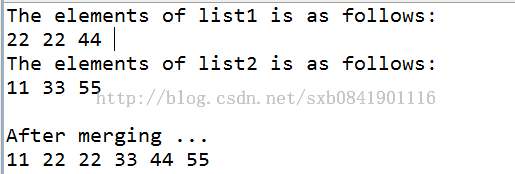【DataStructure】Some useful methods about linkedList(三)
Method 4: Gets the value of element number i
For example, if list is {22, 33, 44, 55, 66, 77, 88, 99}, then get(list, 2) will return 44.
Solution 1:
static int get(Node list, int i) {
if (i < 0) {
throw new IllegalArgumentException();
}
for (int j = 0; j < i; j++) {
if (list == null) {
throw new IllegalStateException();
}
list = list.next;
}
return list.data;
}
Solution 2:
static int get(Node list, int i)
{
Node p = list;
int j = 0;
while (j < i && p != null) {
++j;
p = p.next;
}
if(p == null)
{
throw new java.util.NoSuchElementException();
}
return p.data;
}
The output is as follows:

Method 5:inserts x as element number i;
For example, if list is {22, 33, 44, 55, 66, 77, 88, 99}, then put(list, 3, 50) will change List to {22, 33, 44, 50, 55, 66, 44, 88, 99}.
Hint: if i= 0, replace the value of the first node With x, and insert a new node immediately after it that contains the previous fist value.
Solution 1:
static void put(Node list, int i, int x) {
if (list == null) {
throw new java.util.NoSuchElementException("List is Empty");
} else if (i ==0) {
list.next = new Node(list.data,list);
list.data = x;
} else {
Node p = list;
int j = 1;
while (j < i && p != null) {
++j;
p = p.next;
}
if (p == null)
{
String error = String.format("the list has only %d elements", j-1);;
throw new java.util.NoSuchElementException(error);
}
p.next = new Node(x, p.next);
}
}
The output is as follows:

Method 6:Swap the i element with the j element
For example, if list is {22, 33, 44, 55, 66, 77, 88, 99}, then swap(list, 2, 5) will change List to {22, 33, 77, 55, 66, 44, 88, 99}.
static void swap(Node list, int i, int j) {
if (i < 0 || j < 0) {
throw new IllegalArgumentException();
} else if (i == j) {
return;
}
Node p = list, q = list;
for (int ii = 0; ii < i; ii++) {
if (p == null) {
throw new IllegalStateException();
}
p = p.next;
}
for (int jj = 0; jj < j; jj++) {
if (q == null) {
throw new IllegalStateException();
}
q = q.next;
}
int pdata = p.data, qdata = q.data;
p.data = qdata;
q.data = pdata;
return;
}
The output is as follows:

Method 7: Gets a new list that contains all the elements of list1 and list2 in ascending order. List1 and list2 are both in ascending order.
For example, if list1is {22, 33, 55, 88} and list2is {44, 66, 77, 99}, then merged(list1, list2)will return the new list {22, 33, 44, 55, 66, 77, 88, 99}.
Note that the three lists should be completely independent of each other. Changing one list should have no effect upon the others.
static Node merged(Node list1, Node list2) {
Node list = new Node(0);
Node p = list, p1 = list1, p2 = list2;
while (p1 != null && p2 != null) {
if (p1.data < p2.data) {
p = p.next = new Node(p1.data);
p1 = p1.next;
} else {
p = p.next = new Node(p2.data);
p2 = p2.next;
}
}
while (p1 != null) {
p = p.next = new Node(p1.data);
p1 = p1.next;
}
while (p2 != null) {
p = p.next = new Node(p2.data);
p2 = p2.next;
}
return list.next;
}The output is as follows:
